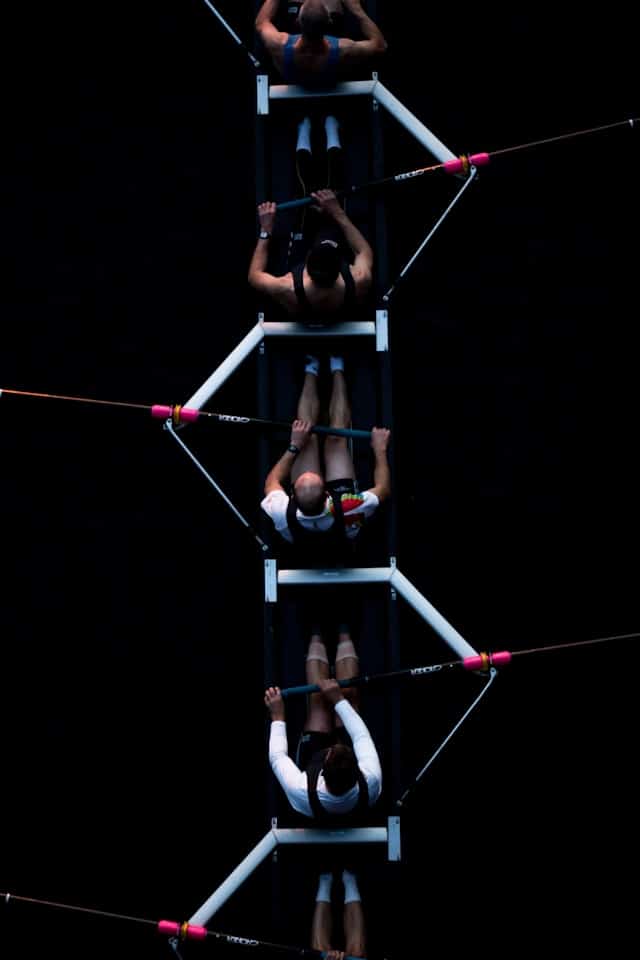If you’ve ever dismissed the notion of indoor rowing, considering it a poor substitute for the real deal, you might want to rethink that position. Indoor rowing, particularly on high-quality rowing machines, is not simply a stand-in for when weather or other factors prohibit outdoor training; it’s a valuable, effective training tool in its own right. In this article, we’ll delve into how indoor rowing competitions can provide substantial benefits for those who typically row on water. You’ll learn about the fitness advantages that rowing machines provide, the variety of training options available, and how indoor rowing can enhance the stroke technique, among other things.
The Fitness Benefits of Indoor Rowing
You might be surprised to learn that rowing machines can give you a comprehensive workout that rivals, and sometimes even surpasses, what you can achieve on water. These machines are designed to simulate the rowing motion as closely as possible, providing resistance that can be adjusted to match your fitness level.
Additional reading : What’s the Impact of Continuous Glucose Monitoring on Cyclists’ Endurance Performance?
Rowing machines target several major muscle groups. Each stroke on the machine involves the legs, arms, and core, making it a full-body workout. This means that while you’re rowing, you’re building strength and endurance in several critical areas.
The cardio benefits of indoor rowing are also significant. A vigorous session on the rowing machine gets the heart pumping, helping to improve cardiovascular fitness over time.
Also read : How Can Golfers Adjust Their Swing Mechanics for Windy Conditions on the Course?
Moreover, rowing machines allow for controlled, measurable workouts. You can monitor time, distance, and strokes per minute, allowing you to track progress and set goals.
The Training Versatility of Rowing Machines
One of the biggest advantages of using rowing machines for training is their versatility. Whether you’re a long-time rower or a novice, you will find indoor rowing offers a range of workout options that can be tailored to your specific needs and goals.
Interval training is one such option. By alternating between high-intensity and low-intensity periods, you can significantly improve your stamina and endurance. This kind of training can be particularly beneficial for those preparing for long-distance rowing events.
Another benefit of rowing machines is that they allow for resistance adjustments. By changing the resistance setting, you can simulate different water conditions, making your training more comprehensive and effective.
Last but not least, rowing machines can facilitate team workouts. Crews can train together, synchronising their strokes and building cohesion, even when they can’t get on the water.
Enhancing Stroke Technique with Indoor Rowing
Another advantage of indoor rowing is the opportunity it provides for enhancing stroke technique. On the water, many factors can influence the stroke, such as current and wind. In contrast, rowing machines provide a stable, controlled environment where you can focus purely on your technique.
Practising form on a rowing machine can lead to a more efficient and powerful stroke on the water. The consistent resistance provided by the machine allows you to focus on each phase of the stroke — the catch, drive, finish, and recovery.
Furthermore, most modern rowing machines come with real-time feedback. You can monitor your stroke rate, power output, and even stroke length, providing valuable data to refine your technique.
Indoor Rowing Competitions: A Unique Challenge
Participating in indoor rowing competitions can offer a unique challenge and a change of pace from traditional water-based events. These races typically involve rowing a set distance on a machine as fast as possible, with participants competing against the clock or each other.
Such competitions test not only physical fitness but mental toughness as well. The unchanging scenery and repetitive motion require focus, determination, and resilience, teaching rowers to maintain their technique and pacing under pressure.
Moreover, these events provide a platform for rowers of all levels to compete. Unlike water-based competitions, which often require specific conditions and equipment, indoor rowing competitions are more accessible. They can be held anytime, anywhere, making it easier for more people to participate — and for you to measure your skills against a broader range of competitors.
The Complementary Role of Indoor and Water-Based Rowing
Water-based rowing and indoor rowing are not mutually exclusive; in fact, they complement each other perfectly. The controlled environment of the rowing machine allows for focused, measurable training, while the unpredictability of the outdoors provides a real-world application of these skills.
Incorporating indoor rowing into your training regimen can help you become a more well-rounded rower. It’s not just about mimicking water-based rowing; it’s about enhancing it. The strength, endurance, technique, and mental toughness you develop on the machine will translate directly to improved performance on the water.
The Physical and Mental Health Advantages of Indoor Rowing
Many people cringe at the idea of a workout, often associating it with pain, discomfort, and exhaustion. However, with a rowing machine, you can have a low impact, full body workout that won’t put excessive strain on your joints. Indoor rowing allows you to engage multiple muscle groups in one fluid motion, providing an efficient and comprehensive workout.
What makes rowing machines standout fitness equipment is their ability to provide both cardiovascular and strength training benefits. The steady state motion of the rowing stroke improves heart rate and respiration, promoting better cardiovascular health. Simultaneously, the resistance provided by the machine, whether it’s a water rower or a magnetic rower, challenges your muscles, leading to increased strength and endurance.
In addition to the physical benefits, indoor rowing has significant mental health advantages. It’s a form of exercise that requires focus and concentration, helping to clear your mind and relieve stress. The rhythmic, repetitive motion can be meditative, promoting a sense of calm and well-being. Research has shown that such exercises can improve mood, reduce anxiety, and even boost self-esteem.
Additionally, indoor rowers come with various settings and features that enable you to customize your rowing experience. You can adjust the machine’s resistance, speed, and duration according to your fitness level and goals, making indoor rowing accessible and beneficial for everyone, regardless of their rowing or fitness background.
The Role of Indoor Rowing Competitions in Enhancing Performance
Indoor rowing competitions provide a platform to test and enhance the skills developed on the rowing machine. These competitions put your strength, endurance, and technique to the test, and can provide a competitive edge for water rowers.
One key benefit of these competitions is that they allow for performance tracking. You can monitor your stroke rate, distance covered, and time taken, providing an objective measure of your performance. This data can be incredibly useful in identifying areas of strength and those that need improvement, allowing you to tailor your training accordingly.
During a competition, maintaining a steady pace and consistent stroke rate can be a challenge, particularly as fatigue sets in. However, these are precisely the circumstances under which water rowers often find themselves during a race. Therefore, indoor rowing competitions can simulate the pressures of an outdoor race, helping rowers develop the resilience and mental toughness needed to succeed on the water.
Moreover, indoor rowing competitions break down barriers to participation that are usually associated with water rowing. They don’t require access to specific venues or bodies of water, nor do they require favorable weather conditions. This makes them more accessible to a wider range of participants, increasing the level of competition and offering water rowers the opportunity to compete against a diverse set of competitors.
Conclusion
In conclusion, indoor rowing is not just a substitute for outdoor rowing but a valuable addition to any rower’s training regimen. The fitness benefits of a rowing machine, the versatility it offers in terms of training options, and the opportunity to refine stroke technique make indoor rowing an effective way to enhance water rowing performance.
Moreover, indoor rowing competitions provide a unique challenge and offer a platform to test and improve performance in a controlled yet competitive environment. Whether you’re a seasoned water rower or a beginner looking to get into the sport, incorporating indoor rowing into your routine is likely to provide tangible benefits. Embrace the challenge of the indoor rower, and you might just find your performance on the water reaching new heights.






